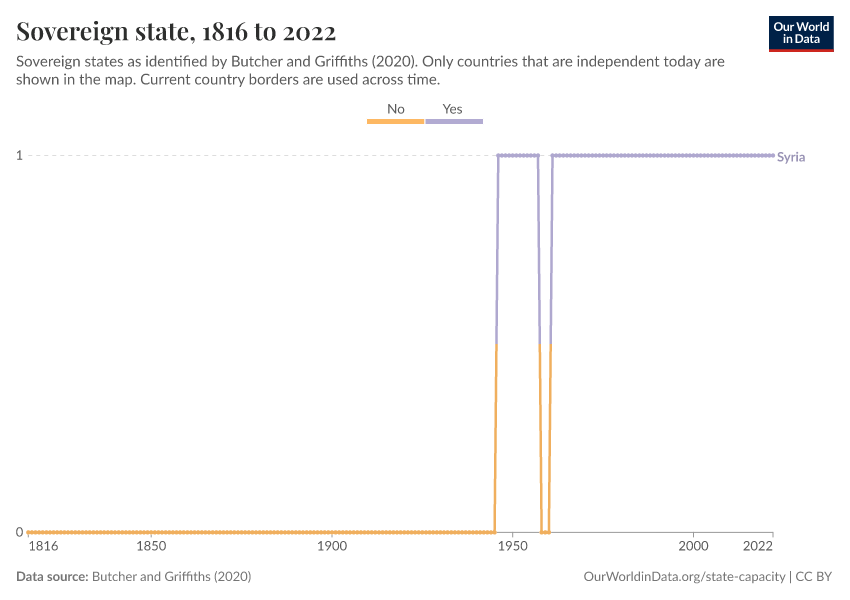Sovereign state

What you should know about this indicator
Butcher and Griffiths consider a country a sovereign state if it has a population of at least 10,000 people, has internal control over much of its territory, and is externally recognized by its peers and controls its foreign relations.
What you should know about this indicator
Butcher and Griffiths consider a country a sovereign state if it has a population of at least 10,000 people, has internal control over much of its territory, and is externally recognized by its peers and controls its foreign relations.
Sources and processing
This data is based on the following sources
How we process data at Our World in Data
All data and visualizations on Our World in Data rely on data sourced from one or several original data providers. Preparing this original data involves several processing steps. Depending on the data, this can include standardizing country names and world region definitions, converting units, calculating derived indicators such as per capita measures, as well as adding or adapting metadata such as the name or the description given to an indicator.
At the link below you can find a detailed description of the structure of our data pipeline, including links to all the code used to prepare data across Our World in Data.
Notes on our processing step for this indicator
We assign each sovereign state to a region based on the mapping (using ISD/COW codes):
- Americas: 2-165
- Europe: 200-395, 2558, 3375
- Africa: 400-626, 4044-6257
- Middle East: 630-698, 6821-6845
- Asia and Oceania: 700-990, 7003-9210
We also provide the following extra regions (note that this overlap with 'Africa' and 'Middle East'). These regions are used in Project Mars dataset.
- North Africa and the Middle East: 435-436, 483, 600-698, 4352-4354, 4763, 4832, 6251-6845
- Sub-Saharan Africa: 402-434, 437-482, 484-591, 4044-4343, 4362-4761, 4765-4831, 4841-5814
Reuse this work
- All data produced by third-party providers and made available by Our World in Data are subject to the license terms from the original providers. Our work would not be possible without the data providers we rely on, so we ask you to always cite them appropriately (see below). This is crucial to allow data providers to continue doing their work, enhancing, maintaining and updating valuable data.
- All data, visualizations, and code produced by Our World in Data are completely open access under the Creative Commons BY license. You have the permission to use, distribute, and reproduce these in any medium, provided the source and authors are credited.
Citations
How to cite this page
To cite this page overall, including any descriptions, FAQs or explanations of the data authored by Our World in Data, please use the following citation:
“Data Page: Sovereign state”, part of the following publication: Bastian Herre and Pablo Arriagada (2023) - “State Capacity”. Data adapted from Butcher and Griffiths. Retrieved from https://archive.ourworldindata.org/20251208-134119/grapher/sovereign-state-butcher-griffiths.html [online resource] (archived on December 8, 2025).How to cite this data
In-line citationIf you have limited space (e.g. in data visualizations), you can use this abbreviated in-line citation:
Butcher and Griffiths (2020) – with minor processing by Our World in DataFull citation
Butcher and Griffiths (2020) – with minor processing by Our World in Data. “Sovereign state” [dataset]. Butcher and Griffiths, “International System Dataset version 2” [original data]. Retrieved December 27, 2025 from https://archive.ourworldindata.org/20251208-134119/grapher/sovereign-state-butcher-griffiths.html (archived on December 8, 2025).